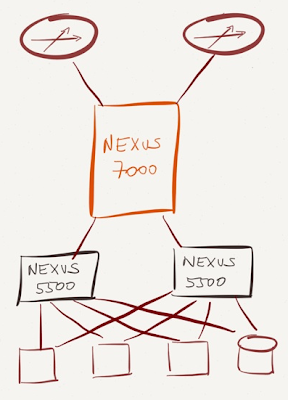Why Exactly Would You Want a Nexus 7000 in There?
Network designers (and smart consulting and system integration companies) often use ExpertExpress to get a second opinion on a design someone put together using technologies they’re not thoroughly familiar with. Not surprisingly, some of those third-party designs aren’t exactly optimal.
A while ago I was asked to review a data center “design” proposed to my customer by a system integrator. It had a pair of Nexus 5500 switches connecting servers and storage to a single Nexus 7000, which was then connected to WAN edge routers.
I tried to understand what the role of the Nexus 7000 was, as it looked more like a really expensive bump-in-the-wire in that particular design (not to mention it also acted as a nice single-blob-of-failure). The only potential use cases we could see for that box were:
- Layer-3 forwarding, which could be performed on either Nexus 5500 switches or WAN edge routers;
- OTV for potential data center extension, and the customer didn’t have the second data center or immediate plans to deploy one.
Please note I’m not picking on the Nexus 7000 or its features. It’s just that it was not needed in that particular design. On the other hand, don’t try to persuade me how redundant supervisors in a single box remove a single point of failure.
At that time OTV was already available on ASR1K routers, and the customer already had plans to replace existing WAN edge routers with ASR1Ks, so the OTV argument was gone. We analyzed the potential drawbacks of running layer-3 forwarding on either Nexus 5500s (performance limitations of layer-3 daughterboard and lack of ISSU), but quickly realized that:
- The
256160 Gbps of layer-3 throughput offered by Nexus 5500 was more than enough; - ISSU was a non-issue – the customer could easily get the job done with a single Nexus 5500; temporarily losing the other box wasn’t such a big deal.
End result: the customer saved several hundred thousand dollars with a single one-hour consulting session.
I know it was an extremely low-hanging fruit, but I simply couldn’t resist writing about it.


Incidentally, when we inquired about future Layer-3 for 5k platforms, we learned that 5k and 7k were different internal business units at Cisco and there was quite a bit of contention as the platforms overlapped. We were thinking that if they just add a few more features, we'd probably use the 5ks far more frequently for L3-switching .
CWB
Similar to the last anonymous poster, we did use a single Nexus 7000 per site to build a separate backup network at one point. And then our app teams proceeded to use the non-redundant "backup" network to access NFS shares for databases used by mission critical applications...
As for the SPOF, I agree, a single box is a SPOF. At a different degree depending on hardware and software redundancy, but still a SPOF. A single Control Plane with 2 physical devices is also a SPOF.